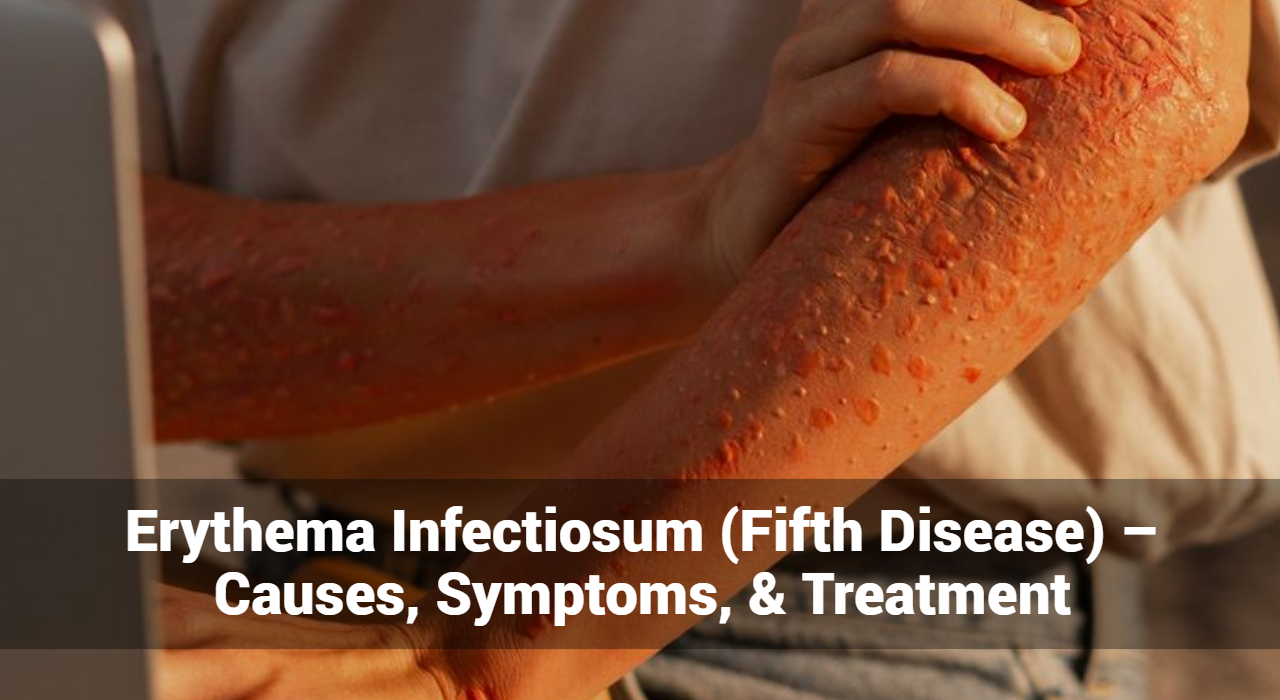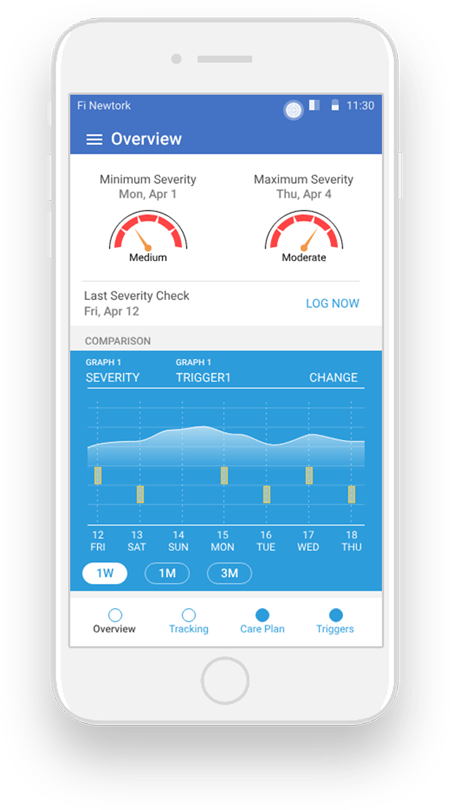Erythema Infectiosum (Fifth Disease) – Causes, Symptoms, & Treatment

Erythema infectiosum, commonly known as fifth disease, is a highly contagious viral infection primarily affecting children. Recognized by its distinctive “slapped cheek” rash, erythema infectiosum is generally mild but can pose significant risks to certain populations. This article delves into the details of erythema infectiosum, exploring its causes, symptoms, and treatment.
What Is Erythema Infectiosum?
Erythema infectiosum is caused by the human parvovirus B19. It is one of several childhood exanthems (rashes) and is so named because it was historically the fifth disease in a classification of common childhood rashes. The condition is typically mild in healthy children but can have more severe implications for adults and individuals with weakened immune systems.
What Are The Causes of Erythema Infectiosum?
Erythema infectiosum, also known as fifth disease, is a viral infection primarily caused by the human parvovirus B19. This section will delve into the specific causes and contributing factors associated with erythema infectiosum.
Primary Cause: Human Parvovirus B19
Human parvovirus B19 is the sole causative agent of erythema infectiosum. This virus specifically targets and infects red blood cell precursors in the bone marrow, leading to a temporary disruption in red blood cell production. The infection process and subsequent immune response are what primarily lead to the symptoms observed in erythema infectiosum.
Transmission Methods
Erythema infectiosum spreads primarily through the following means:
- Respiratory Droplets: The most common transmission route is via respiratory droplets. When an infected person coughs or sneezes, they release tiny droplets containing the virus into the air. These droplets can be inhaled by nearby individuals, leading to infection.
- Direct Contact: The virus can also spread through direct contact with respiratory secretions. For example, sharing utensils, drinks, or touching surfaces contaminated with these secretions can facilitate the spread of the virus.
- Blood Transmission: Less commonly, human parvovirus B19 can be transmitted through blood or blood products. This can occur through transfusions, organ transplants, or shared needles.
- Vertical Transmission: Pregnant women infected with human parvovirus B19 can transmit the virus to their fetus. This vertical transmission can lead to severe complications such as fetal anemia or hydrops fetalis.
Track and Manage your Eczema treatment using a comprehensive Eczema App
Download Eczemaless now
Factors Contributing to the Spread
Several factors contribute to the spread and impact of erythema infectiosum:
- Seasonal Variation: Outbreaks of erythema infectiosum are more common in late winter and early spring, although the virus can circulate year-round.
- Close Contact Environments: Settings such as schools, daycare centers, and households where individuals are in close proximity to each other facilitate the spread of the virus. Children are particularly susceptible due to their close interactions and developing immune systems.
- Immunocompromised Individuals: People with weakened immune systems, including those undergoing chemotherapy, organ transplant recipients, or individuals with HIV, are more susceptible to infection and may experience more severe symptoms.
- Chronic Anemia Conditions: Individuals with chronic anemia conditions, such as sickle cell disease or hereditary spherocytosis, are at higher risk for complications if they contract erythema infectiosum. The virus can exacerbate their condition by further disrupting red blood cell production.
Pathogenesis
The pathogenesis of erythema infectiosum involves several stages:
- Viral Entry and Replication: The human parvovirus B19 enters the body through the respiratory tract and initially replicates in the nasopharynx.
- Viremia: The virus then enters the bloodstream, leading to viremia. During this stage, the infected individual may experience flu-like symptoms.
- Immune Response: The body’s immune response to the virus results in the characteristic symptoms of erythema infectiosum, including the distinctive rash and joint pain. The immune response also helps to clear the virus from the body.
- Bone Marrow Suppression: Human parvovirus B19 targets red blood cell precursors in the bone marrow, temporarily halting their production. This effect is usually mild and transient in healthy individuals but can be severe in those with pre-existing anemia conditions.
Erythema infectiosum is caused by the human parvovirus B19, which spreads primarily through respiratory droplets, direct contact with infected secretions, blood transmission, and vertical transmission from mother to fetus.
What Are The Symptoms of Erythema Infectiosum?
Erythema infectiosum, commonly known as fifth disease, is a viral infection with a distinctive set of symptoms that evolve through different stages of the illness. Understanding these symptoms helps in early recognition and appropriate management of the condition.
Incubation Period
The incubation period for erythema infectiosum ranges from 4 to 14 days, although it can extend to 21 days in some cases. During this time, the infected person may not exhibit any noticeable symptoms.
Early Symptoms
Initial symptoms are often mild and nonspecific, resembling those of a common cold or flu. These can include:
- Mild Fever: A low-grade fever is common, typically around 101°F (38.3°C).
- Headache: Generalized headache.
- Flu-like Symptoms: Including fatigue, muscle aches, and malaise.
- Sore Throat: Mild throat irritation or soreness.
- Runny or Stuffy Nose: Symptoms similar to a mild upper respiratory infection.
Rash Development
The hallmark of erythema infectiosum is its characteristic rash, which progresses through distinct stages:
- “Slapped Cheek” Rash:
- Appearance: Bright red rash on both cheeks, giving the appearance of slapped cheeks.
- Timing: This facial rash typically appears after the early symptoms have subsided and the fever has resolved.
- Common in Children: This symptom is most prominent in children and less common in adults.
- Body Rash:
- Appearance: A lacy, red rash that can spread from the face to the trunk, arms, and legs.
- Pattern: The rash has a reticular (net-like) pattern, often described as lacy or “fishnet-like.”
- Itching: The body rash may be itchy, though the severity of itching varies.
- Reappearance:
- Triggers: The rash can fade and reappear over several weeks, often triggered by factors such as sunlight exposure, heat, exercise, or stress.
- Fluctuation: The intensity and distribution of the rash can fluctuate, appearing more pronounced under certain conditions.
Joint Pain and Swelling
Joint involvement is more common in adults than in children and can include:
- Arthralgia: Pain in the joints, commonly affecting the hands, wrists, knees, and ankles.
- Arthritis: In some cases, there may be swelling and inflammation of the joints, leading to arthritis-like symptoms.
- Duration: Joint pain and swelling can last from a few days to several weeks or even months, but they typically resolve without long-term damage.
Additional Symptoms
In addition to the classic rash and joint symptoms, erythema infectiosum can present with other signs, especially in adults or those with compromised immune systems:
- Generalized Fatigue: Persistent tiredness and lack of energy.
- Gastrointestinal Symptoms: Mild nausea or abdominal discomfort in some cases.
- Respiratory Symptoms: Cough and mild respiratory distress.
GET IN CONTROL OF YOUR ECZEMA
Use our AI tool to check the severity of Eczema and keep track of your Eczema progress.
Treatment of Erythema Infectiosum
While it usually resolves on its own without specific antiviral treatment, managing the symptoms can provide relief and prevent complications. Here’s an in-depth look at the treatment strategies for erythema infectiosum.
General Management
The cornerstone of treating erythema infectiosum involves supportive care to alleviate symptoms and ensure comfort. Here are the key approaches:
Symptomatic Relief
- Fever and Pain: Over-the-counter medications such as acetaminophen (Tylenol) or ibuprofen (Advil, Motrin) can be used to reduce fever and relieve pain, including headache and joint discomfort.
- Itching: Antihistamines (such as diphenhydramine or cetirizine) may help reduce itching associated with the rash.
Hydration and Rest
- Fluids: Encourage adequate fluid intake to stay hydrated, especially if the patient has a fever.
- Rest: Ensure plenty of rest to help the body recover from the viral infection.
- Moisturizers: Use gentle moisturizers to soothe irritated skin.
- Avoid Triggers: Minimize exposure to sunlight, heat, and activities that might exacerbate the rash.
Specific Considerations for Different Populations
Children
- Comfort Measures: Ensuring comfort through appropriate clothing and a cool environment can help manage symptoms.
- Monitoring: Keep an eye on symptoms and ensure they don’t escalate, particularly if the child has underlying health issues.
Adults
- Joint Pain Management: Since joint pain and swelling are more common in adults, NSAIDs like ibuprofen can be particularly helpful. In some cases, more potent anti-inflammatory medications may be needed.
Pregnant Women
- Monitoring: Pregnant women who contract erythema infectiosum should be closely monitored due to the risk of fetal complications. Regular ultrasounds may be recommended to check for signs of fetal distress, such as hydrops fetalis.
- Medical Consultation: Immediate consultation with a healthcare provider is essential if a pregnant woman is exposed to or develops symptoms of erythema infectiosum.
Immunocompromised Individuals
- Medical Management: Those with weakened immune systems, such as patients undergoing chemotherapy or those with HIV, may require more intensive medical care. This can include antiviral medications and treatments to support the immune system.
- Monitoring for Complications: Close monitoring for potential complications, such as severe anemia, is crucial.
Individuals with Chronic Anemia
- Aplastic Crisis Management: Individuals with health conditions like sickle cell disease or other hemolytic anemias are at risk for aplastic crises. Treatment may include blood transfusions and hospitalization to manage severe anemia.
- Regular Check-ups: Ongoing monitoring and supportive care to manage their underlying condition and prevent complications.
Preventive Measures
Good Hygiene Practices
- Hand Washing: Regular and thorough hand washing with soap and water can help prevent the spread of the virus.
- Respiratory Etiquette: Covering the mouth and nose with a tissue or elbow when coughing or sneezing can reduce the risk of transmission.
Avoiding Exposure
- Stay Home: Infected individuals, especially children, should stay home from school or daycare during the contagious period to prevent spreading the virus to others.
- Isolate: Avoid close contact with others, particularly vulnerable groups such as pregnant women and immunocompromised individuals.
When to Seek Medical Attention
While erythema infectiosum is typically mild, certain situations warrant medical attention:
- Severe Symptoms: Persistent high fever, severe headache, or intense joint pain.
- Complications: Signs of complications such as difficulty breathing, significant swelling, or prolonged symptoms.
- Pregnancy: If a pregnant woman is exposed to the virus or develops symptoms.
- Immunocompromised Individuals: Any signs of severe illness or complications in individuals with weakened immune systems.
Prevention of Erythema Infectiosum
Preventive measures focus on good hygiene and avoiding exposure to the virus:
- Good Hygiene Practices: Frequent handwashing, avoiding close contact with infected individuals, and proper respiratory etiquette (covering mouth and nose when coughing or sneezing).
- Avoiding Exposure: Pregnant women and immunocompromised individuals should avoid contact with known cases of erythema infectiosum.
Conclusion
Erythema infectiosum is a common viral infection marked by its characteristic rash and mild flu-like symptoms. While typically mild, it can lead to complications in pregnant women, immunocompromised individuals, and those with chronic anemia. Understanding the causes, symptoms, and treatment options for erythema infectiosum can help manage and prevent the spread of this infection effectively. With proper care and preventive measures, the impact of erythema infectiosum can be minimized, ensuring better health outcomes for affected individuals.
Track and Manage your Eczema treatment using a comprehensive Eczema App
Download Eczemaless now



